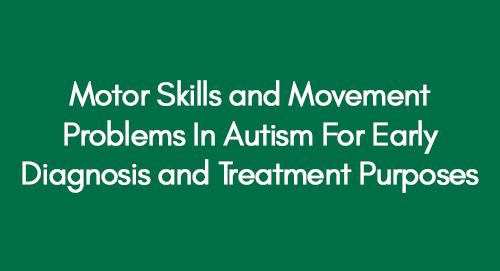
Emotional Intelligence (EI) and Interpersonal Skills (IPS): The Moderating Role of Attachment Style (AS)
July 6, 2022
How Technology Can Be Used to Change the Face of Tertiary Education System: Integrating Mobile Learning into Tertiary Education and Barriers.
July 6, 2022In the diagnostic ballet of autism, motor skills and movement problems pirouette as early indicators, gracefully choreographing a dance between identification and intervention. Each nuanced step becomes a diagnostic brushstroke, painting a portrait of early understanding that identifies the rhythm of challenges and sets the stage for a therapeutic symphony in the pursuit of developmental harmony.
Autism Spectrum Disorder (ASD) refers to a developmental disorder that typically develops in late infancy or early childhood, and is defined by emotional and cognitive disorders that hinder optimum functioning. Despite extensive study and increased media knowledge,
Discover Further Information About Autism Spectrum Disorder (ASD) Here
Autism has an uncertain etiology, with no proven treatment, making precise with prompt diagnosis difficult to obtain. Moreover, after an ASD diagnosis is made, parents find it difficult to follow the healthcare system and decide which treatments are more successful and beneficial for their child [1]. Early diagnosis of autism is crucial for facilitating early intervention, however, several children experience considerable diagnostic delays. Such gaps are caused by a shortage of primary care professionals, insufficient resources at autism facilities, and regional and socioeconomic barriers [2].
Recent development has contributed to faster identification, and extensive phenotyping efforts focused on high-risk children have continued to advance analysis of early trajectories of behavior. A biomarker that tests early structural and functional connectivity, visual orientation, and other biological functions has demonstrated the ability to predict the likelihood of autism spectrum disorder well before evident behavioral signs emerged. Despite these advancements, the average diagnostic age remains 4-5 years [3]. The research suggests that young children with ASD benefit from early intervention, and when a parent-coaching intervention is given their parents learn to incorporate child-responsive communication approaches [4]. There are major difficulties in adequately ascertaining children who may be at risk of ASD at an early age and providing them with effective early support. Medical personnel and public care programs have dealt with these problems, including gaps in detecting potential ASD and referral for evaluations [5].
Movement and Motor Skills Problems
Several studies have been conducted to understand the importance of motor skills in diagnosing autism in the early stages of an individual’s life to understand the neurological disorder efficiently. Children with Autism Spectrum Disorder (ASD) have general deficits in balance, pace, and coordination as well as autism-specific disabilities in praxis/motor coordination and interpersonal synchrony. Research results demonstrate that there is a dire need for physicians and educators to provide motor assessments and procedures in the routine treatment of children with ASD, and to accept dyspraxia as an important part of the concept of ASD in the wider autism community [6]. Standard foundational pillars for autism spectrum disorder (ASD) diagnosis include cognitive cognition and social contact delays, as well as conventional or repeated behavioral habits. There is a fair understanding that motor deficits constitute an ASD prodrome within the first year of life, paediatricians should not rule out the risk of ASD in children with motor behaviors. Evidence over the past decade shows that developmental motor defects during early childhood are significant predictors of this diagnosis, which on its own is difficult to determine [7].
Despite the evidence that an early motor delay is one of the first signs of a potential diagnosis of autism spectrum disorder, relatively few motor behavior treatments persist as the preferred outcome for young children with an autism spectrum disorder. Repeated covariance analysis revealed statistically important variations between the classes in all three motor results, locomotive and gross quotient [8]. Motor activity tests in ASD have lagged behind other behavioral phenotypes. Quantitative and Neuro-diagnostic evaluations of Motor function may aid in identifying common motor impairments in ASD and the underlying neurological processes which could be associated. Input from modern quantitative and Neuro-diagnostic motor function approaches leads to a deeper knowledge of the clear and implicit motor impairments in ASD, and the motor function relationship to language and social development [9]. In another study the impact of a prescribed social practice known as Sports, Play, and Active Recreation for Kids (SPARK) on the motor and behavioral abilities of children with autism spectrum disorder (ASD) using a quasi-experimental method of repeated controls. The findings of the study show that the practice of the SPARK can be used as a therapeutic tool not just for improving motor skills but also for improving social skills in children with ASD [10].
Weak motor skills are considered to be related to broader social cognitive problems. Many recent findings indicate that music, by influencing brain connectivity, can enhance sensory processing and motor functions. The findings showed that both treatments increased motor performance in the patients. Movement therapy is useful for children with autism because movement exercises in combination with music could enhance these children's motor skills progress [11]. It is argued that a more complex understanding of the omnipotence of ASD-specific motor disorders is required, and there is a range of major methodological concerns, including comorbidity, limited sample sizes, lack of substantive subtyping, omission of persons with a cognitive disability, and lack of longitudinal cross-syndrome designs [12].
Future Implications
To address these technical difficulties, a coordinated effort would be necessary across several areas with advancements in computational methods in neuroimaging and micro-movement research that carry a great deal of potential for early detection, development of coherent pathophysiology models, and customized therapies to cover the broader range of cognitive abilities within ASD [12]. It is also important to note that the correlation between motor skills and speech and language delays identified in other developmental disabilities raises important concerns about a possible association between motor skills and ASD speech-language delays. Findings indicate possible variations in the contribution to autistic characteristics of fine versus gross motor functions, which can offer another framework for evaluating cognitive disparities across the autism continuum for inclusion in clinical strategies [13]. Moreover, The research conducted by Holloway, Long, and Biasini, confirms the parallel validity of the Miller Function and Participation Scales with the Peabody Developmental Motor Scales, Second Edition for ASD patients. Although both tests provide information about the motor delay, the M-FUN can offer additional details about the child's neurological evaluation [14]. This provides further evidence that motor skills and movement issues play an important role in Autism for early diagnosis and treatment purposes.
References
[1] Elder, J.H., Kreider, C.M., Brasher, S.N. and Ansell, M., 2017. Clinical impact of early diagnosis of autism on the prognosis and parent–child relationships. Psychology research and behavior management.
[2] Mazurek, M.O., Curran, A., Burnette, C. and Sohl, K., 2019. ECHO Autism STAT: accelerating early access to autism diagnosis. Journal of autism and developmental disorders, 49(1), pp.127-137.
[3] Zwaigenbaum, L. and Penner, M., 2018. Autism spectrum disorder: advances in diagnosis and evaluation. Bmj, 361, p.k1674.
[4] Landa, R.J., 2018. Efficacy of early interventions for infants and young children with, and at risk for, autism spectrum disorders. International Review of Psychiatry, 30(1), pp.25-39.
[5] Rotholz, D.A., Kinsman, A.M., Lacy, K.K. and Charles, J., 2017. Improving early identification and intervention for children at risk for autism spectrum disorder. Pediatrics, 139(2), p.e20161061.
[6] Kaur, M., Srinivasan, S.M. and Bhat, A.N., 2018. Comparing motor performance, praxis, coordination, and interpersonal synchrony between children with and without Autism Spectrum Disorder (ASD). Research in developmental disabilities, 72, pp.79-95.
[7] Harris, S.R., 2017. Early motor delays as diagnostic clues in autism spectrum disorder. European journal of pediatrics, 176(9), pp.1259-1262.
[8] Ketcheson, L., Hauck, J. and Ulrich, D., 2017. The effects of an early motor skill intervention on motor skills, levels of physical activity, and socialization in young children with autism spectrum disorder: A pilot study. Autism, 21(4), pp.481-492.
[9] Wilson, R.B., Enticott, P.G. and Rinehart, N.J., 2018. Motor development and delay: advances in assessment of motor skills in autism spectrum disorders. Current opinion in neurology, 31(2), pp.134-139.
[10] Najafabadi, M.G., Sheikh, M., Hemayattalab, R., Memari, A.H., Aderyani, M.R. and Hafizi, S., 2018. The effect of SPARK on social and motor skills of children with autism. Pediatrics & Neonatology, 59(5), pp.481-487.
[11] Sanglakh Goochan Atigh, A., Akbarfahimi, M. and Alizadeh Zarei, M., 2017. The effect of movement activities in synchronization with music on motor proficiency of children with autism. Journal of Advanced Medical Sciences and Applied Technologies, 3(2), pp.61-68.
[12] Hocking, D.R. and Caeyenberghs, K., 2017. What is the nature of motor impairments in autism, are they diagnostically useful, and what are the implications for intervention?. Current Developmental Disorders Reports, 4(2), pp.19-27.
[13] Mody, M., Shui, A.M., Nowinski, L.A., Golas, S.B., Ferrone, C., O’Rourke, J.A. and McDougle, C.J., 2017. Communication deficits and the motor system: exploring patterns of associations in autism spectrum disorder (ASD). Journal of autism and developmental disorders, 47(1), pp.155-162.
[14] Holloway, J.M., Long, T. and Biasini, F., 2019. Concurrent validity of two standardized measures of gross motor function in young children with autism spectrum disorder. Physical & occupational therapy in pediatrics, 39(2), pp.193-203.
Get 3+ Free Dissertation Topics within 24 hours?




























